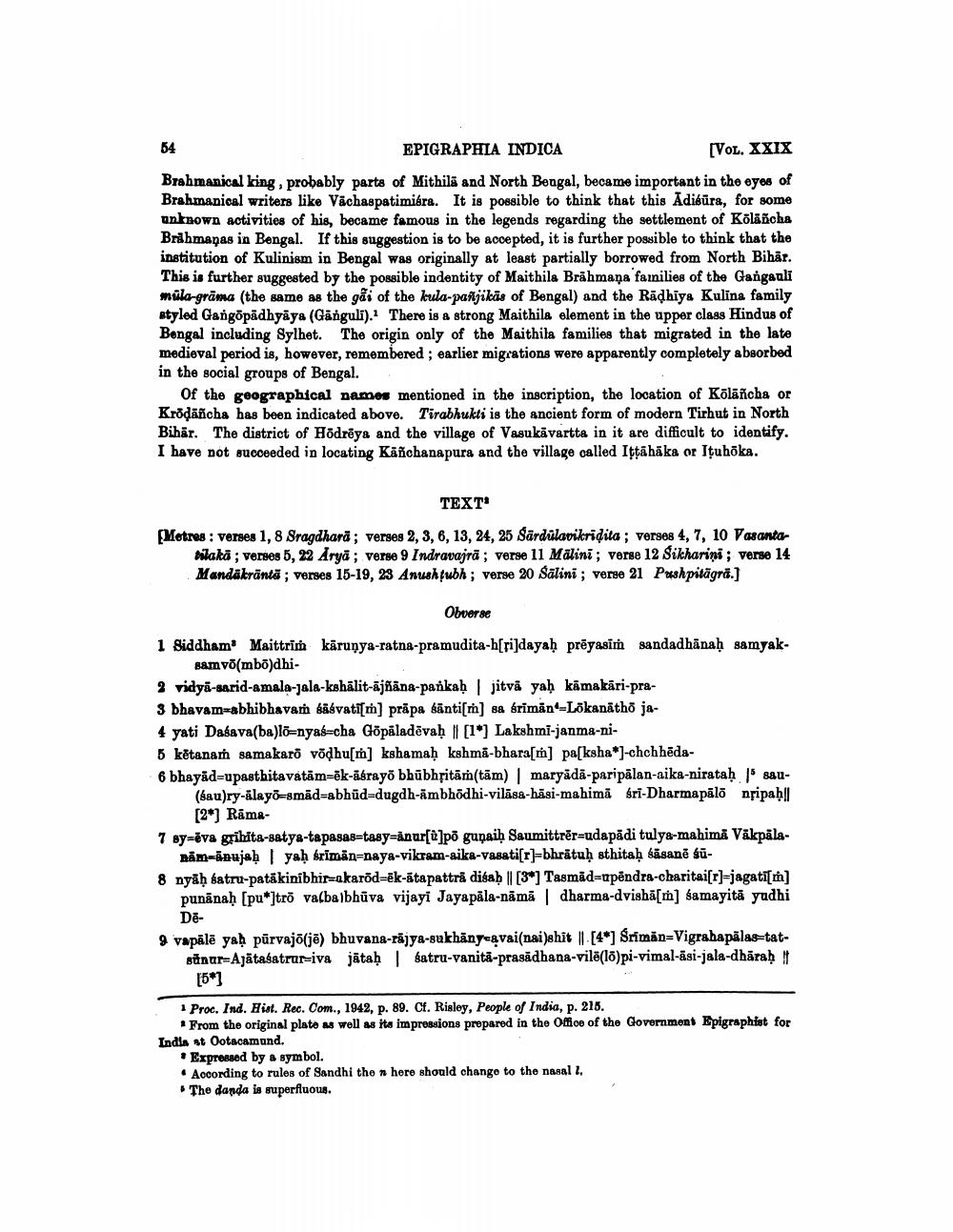________________
EPIGRAPHIA INDICA
[VOL. XXIX
Brahmanical king, probably parts of Mithilā and North Bengal, became important in the eyes of Brahmanical writers like Vāchaspatimiára. It is possible to think that this Adibūra, for some unknown activities of his, became famous in the legends regarding the settlement of Kölāñcha Brahmanas in Bengal. If this suggestion is to be accepted, it is further possible to think that the institution of Kulinism in Bengal was originally at least partially borrowed from North Bihär. This is further suggested by the possible indentity of Maithila Brāhmana fainilies of the Gangauli müla-grāma (the same as the gãi of the kula-pañjikās of Bengal) and the Rādhiya Kulina family styled Gangopadhyaya (Gänguli). There is a strong Maithila element in the upper class Hindus of Bengal including Sylhet. The origin only of the Maithila families that migrated in the late medieval period is, however, remembered ; earlier migrations were apparently completely absorbed in the social groups of Bengal.
of the geographical names mentioned in the inscription, the location of Kõlāñcha or Krödāñcha has been indicated above. Tirabhukti is the ancient form of modern Tirhut in North Bihär. The district of Hödröya and the village of Vasukāvartta in it are difficult to identify. I have not succeeded in locating Kāñchanapura and the village called Itýāhāka or lţuhoka.
TEXT
Motres : verses 1, 8 Sragdhara; verses 2, 3, 6, 13, 24, 25 Särdulavikridita ; verse8 4, 7, 10 Vasanta
bilakā ; verses 5, 22 Arya ; verse 9 Indravajrā; verse 11 Malini ; verse 12 Sikharini ; verse 14 Mandākrāntā ; verses 15-19, 23 Anushfubh ; verse 20 Šālini; verse 21 Pashpitāgrā.]
Obverse 1 Siddham. Maittrīm kārunya-ratna-pramudita-h[rildayaḥ prēyasim sandadhānaḥ samyak
samvõ(mbo)dhi2 vidyā-sarid-amala-jala-kshālit-ājñāna-pankaḥ jitvā yaḥ kāmakāri-pra3 bhavam=abhibhavam sāśvati[m] prāpa sānti[m] sa srimăne-Lökanātho ja4 yati Dabava(ba)lo=nyas-cha Gõpāladēva) || [l*) Lakshmi-janma-ni6 kētanam samakaro võdhu[m] kshamaḥ kshma-bhara[m] pa[ksha*)-chchhēda6 bhayād-upasthitavatām-ök-abrayo bhūbhritām(tām) | maryādā-paripälan-aika-niratah 18 sau
(sau)ry-alayosmād=abhūd=dugdh-ambhodhi-vilāsa-häsi-mahimă sri-Dharmapälö npipaḥ||
[2*) Rāma7 sy=ēva gihita-satya-tapasas-tasy=knar[@]po gunaiḥ Saumittrēr=udapādi tulya-mahim, Väkpala
nām-ánujah yaḥ śrīmān=naya-vikram-aika-Vasati[r]=bhrātuh sthitaḥ sāsané sū8 nyāḥ katru-patikinibhir-akaröd=ēk-ātapattrå disaḥ || [3] Tasmād=upēndra-charitai[r]=jagati[m]
punānah (pu*]tro valbalbhūva vijayi Jayapāla-nāmā | dharma-dvishā[m] samayitä yudhi
Dē9 vapālē ya pūrvajõ(jē) bhuvana-rājya-sukhāny avai(nai)shit I [4*] Sriman=Vigrahapälas-tat
sånar=Ajātasatrur-iva jātaḥ satru-vanitā-prasādhana-vilē(lo)pi-vimal-äsi-jala-dhāraḥ ! [5]
1 Proc. Ind. Hist. Rec. Com., 1942, p. 89. Cf. Risley, People of India, p. 218.
From the original plate as well as its impressions prepared in the Omloo of the Government Epigraphist for India st Ootacamund.
• Expressed by a symbol. • According to rules of Sandhi then here should change to the nagall The danda is superfluous.




